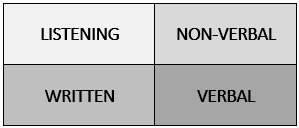Communication is the act of transferring information from one person or place to another. It can be verbal, written, non-verbal or visual (e.g., photographs, diagrams, symbols). The purpose of communication is to understand and to be understood, and it involves expressing thoughts, ideas, and feelings.
Interpersonal communication is a process by which we exchange information, feelings, and meaning with others through verbal and non-verbal messages. It is face-to-face communication.
It is impossible for humans not to communicate. Even when we are not speaking, we are still communicating through our body language. We spend about 75% of our days communicating in some way: about 9% is spent writing, 16% reading, 30% talking, and 45% listening. Effective communication is one of the most important skills that people need in their personal lives and in their work lives.

Figure 1.1 All aspects of communication are integral to building good working relationships.
Verbal communication is how we express ourselves in words, both spoken and written. Spoken language includes enunciation, pauses, stutters, emphasis, and word choice. Spoken language can occur in face-to-face encounters, by telephone, by voice mail, on television, by Web conferencing, or on radio.
Verbal communication is an essential skill for a tradesperson to master, whether it is used to ask questions while an apprentice or explain something as a journeyperson, using verbal communication effectively improves productivity and ability to work well with others among other things. Verbal communication includes an understanding of the use of gender-neutral language and terms, use of respectful language when communicating with someone, and respecting and identifying the differences in communication styles of people.
Gender neutral
Gender-neutral language use is important in a diverse workplace, assumptions should never be made as to what a person’s preferred pronouns or name are. The simplest way to avoid making a mistake when referring to someone else is to use the name they have introduced themselves to you with to refer to them. This avoids the use of pronouns that they do not identify with. Some examples of gender-neutral pronouns that you can use when referring to others are, they, them, and their. These pronouns do not make assumptions about the gender that a person may identify as. Another way that gender neutral language can be incorporated into our day-to-day communication is by reframing terms that were previously gendered, such as foreman or journeyman. By using the neutral terms foreperson or journeyperson we do not exclude anyone from these titles.
Respectful
Respectful communication is communication that focuses on topics that are appropriate for your audiences, using manners, allowing others the space to speak, and avoiding topics that are inflammatory, insulting or prejudicial. As individuals, we each have our own unique sets of beliefs, opinions and values, however it is not our place to bestow those upon others without their consent, nor to judge others for theirs. When engaging in respectful verbal communication, particularly with those you do not know well, focus on the subject at hand, common interests, and neutral topics. Use manners, say please and thank you when appropriate, be genuine and apologize for miscommunications. Allow the person you are communicating with space to speak, do not interrupt or take over the conversation, wait your turn.
Microagressions
When engaging in verbal communication you should also be aware of microaggressions, their impact and what can be done to avoid conflict that stems from them. Microaggressions are subtle slights, remarks and actions that occur both consciously and unconsciously and are often linked to our unconscious bias and stereotypes. These remarks are often made based on assumptions and can perpetuate stereotypes of people of other cultures, races, gender identities and sexualities. Sometimes these comments are made in such a way that the person who has made them does not realize they have insulted the other person. These small and seemingly harmless comments and actions are psychologically harmful and have an impact on the overall ability of a work environment to feel inclusive and respectful. It is important to acknowledge our own personal biases and to not allow them to guide our communication with others based on assumptions. Expanding your circles to include a diverse make up of people with whom you interact, being an ally against discrimination and carefully considering your actions and words when interacting with others are keys to avoiding the harm that is created by microaggressions. If you do unknowingly use microaggressions and this is pointed out to you, take the time to listen and acknowledge why this may have been harmful to the other person, do not get defensive about it, and apologize for the comment.
Written communication is another form of verbal communication as it is about language. Written communication can be in the form of letters, handwritten notes, emails, text or instant messages, faxes, books, newspapers, magazines, and signs. Increasingly, daily written communication takes the form of emails and text messages. While these messages may be brief, the potential for miscommunication is significant.
In general, people are better at communicating and interpreting tone in vocal messages than in text-based messages. In emails and text messages, where there is a tendency to reduce the number of words in a message and use abbreviations or slang, the recipient may miss the full meaning or tone intended.
To reduce miscommunication:
- Determine how the information should best be communicated.
- If the subject of your communication is sensitive, consider talking by phone or meeting in person to convey your message rather than sending an email or text message.
- Take your time to compose your message.
- Think about the words you’re writing from the recipient’s perspective.
- Use the KISS principle and “keep it super simple.” The more simply something is stated, the less opportunity there is for confusion or misunderstanding. In the absence of body language and voice tone, the receiver can only rely on the written word.
- Never use email or social networking tools when you are angry or upset. Always wait until you are calm and composed before addressing an issue.
It is also important to mention the appropriate use of pronouns in written communication. Again, here it is best practice not to make assumptions about others, use the pronouns that a person has identified for themselves. If you don’t know, use gender neutral pronouns when referring a person or just refer to them by name. To help others navigate your preferred pronouns you can sign your written communication with pronouns after your name in parenthesis like this: (she/her) (he/him) (they/them), this will help people to communicate with you in the way you wish to be addressed.
In 1967, a University of California, Los Angeles (UCLA) study found that more than 90% of face-to-face communication between people is non-verbal (Mehrabian and Ferris, 1967). Non-verbal communication is communication without words. That’s why it’s often referred to as “body language.” It includes facial expressions, gestures, body movements, posture, and eye contact.
Often a person’s body language reveals their thoughts and feelings more directly than spoken words. Generally, when people are feeling confident, their stance is strong, and they easily make contact with others. When people are flirting, they can be seen playing with their hair, arching their bodies, and standing close to another person. How you use body language can attract or detract from the message that you want to communicate.
Some elements of body language are discussed below.
Facial expressions
The most obvious indicator of emotions is facial expressions. By observing a smile, laughter, tears, a frown, or even the level of eye contact, you can tell much about how a person is feeling. It is important to not jump to conclusions based on appearance alone, although facial expression can guide you as to how to approach an interaction with someone it should not be the only source you rely upon to assess the state of another individual. Resist asking others to change their facial expression to make you feel more comfortable in your interaction, statements like “if you smiled more, you’d look prettier” or “you should be laughing that was funny” are inappropriate. Statements like this are only meeting your own needs, not the needs of the person you are trying to communicate with and harm your ability to engage in meaningful communication with them.

Figure 1.2 Your facial expressions can often convey more than your words.
Appearance
Your personal appearance also communicates an impression. The clothes and accessories you wear, the colours and styles you choose, as well as the piercings and/or tattoos you have can communicate a message about who you are and what you value. When communicating with others we need to be cautious about making judgements about their character based on their appearance. This preconceived notion of what the values or motivations of someone else are based on their appearance is strongly tied to our own unconscious bias.
Personal space
The distance you maintain between yourself and others can vary with the nature of the activity and the emotion involved. For example, people tend to communicate in close proximity if they are affectionate or angry, but at a distance if they are afraid or have a dislike. When communicating with others it is important to respect their personal space when engaging with them. We cannot make assumptions about a person’s level of comfort with someone else in their personal space and invading their space can impact the outcome of our communication with them.
Culture also plays a role in determining personal space. In North America, people tend to keep each other at arm’s length. In some other cultures, individuals stand very close to one another; in others they put significantly more distance between them. Respecting and understanding the diversity of other cultures methods of communication is important to successful communication.
Misinterpreting body language
Body language, like verbal communication, can be misinterpreted. You might someone stomping their foot and think they must be angry. But maybe they’re just trying to get mud off their shoe! Or perhaps you think a co-worker you are talking to is upset with you because their arms are crossed, but maybe they’re just cold.
You shouldn’t focus on just one non-verbal signal and think you’re interpreting effectively. You need to look at the whole package of both verbal and non-verbal cues to better understand what’s being communicated.
Cultural differences
Body language also varies from culture to culture and even from region to region in some countries. The smile may be the one and only gesture that can be understood worldwide.
On large job sites or in other countries, you may be working with individuals from several different cultures, and body language displayed by your supervisors and co-workers may differ from your own. As already noted, North Americans usually converse about an arm’s length apart, but people from other cultures may keep more or less space between them. As well, while maintaining direct eye contact is considered positive for most North Americans, people from other cultures may view it as being confrontational or a sign of disrespect, and therefore they avoid eye contact, particularly with persons of authority.
An understanding of body language is something you will need to acquire when working with others. If your work or travels take you to other countries, understanding the differences between cultures can greatly improve your working relationships and reduce conflict on the job site.
To ensure that you are an effective listener, make sure you provide signals that indicate you’re engaged. Make eye contact and use verbal cues or nodding to show that you’re following the conversation. To indicate that you understand what’s been communicated, ask questions or paraphrase what you’ve heard. Sometimes effective listening is indicated to others by the listener validating a piece of information or specific emotion that was shared with them, statements like “It makes sense that you feel…” or “How can I help?” are simple ways to reflect that you understand the information that they conveyed and are willing to engage with it further. Validation let’s others know that you are listening and that you care about what they have to say and helps to create more meaningful relationships with others. Try to use “open” body language; that is, don’t cross your arms or slouch. Good posture is a way of conveying alertness, and it indicates that you’re paying attention.
Working in the trades usually includes working with others. Whether you are communicating with only one other person or you are in a group setting, effective communication skills are equally important.
Effective and ineffective communication in groups
As you have learned, effective communication spans a variety of different forms, including spoken, written, and non-verbal communication. When working in groups, respecting the principles of effective communication is especially important, as the possibility of interrupting, misinterpreting, or being interrupted or misinterpreted is even greater when more people are involved.
Effective communication is the cornerstone of strong relationships and is one of the factors that helps people work well in groups, whether at home, in school, or in the workplace. Figure 3 lists some of the factors that constitute both effective and ineffective communication when working with others.
Figure 1.3 Examples of effective and ineffective communication | Effective Communication | Ineffective Communication |
|---|
| providing unconditional acceptance | criticizing |
| treating all persons with respect | using words such as “always”, “never”, or “should” |
| validating each person’s feelings and experiences using “I” statements | blaming, dismissing, threatening, or exaggerating |
| being an active listener | being silent as a form of punishment |
| having reasonable expectations of people according to age and abilities | not validating another person’s feelings or experiences |
| encouraging | not apologizing |
| empathizing | entering into power struggles |
| using open-ended questions | name-calling |
| not entering into power struggles | having unreasonable expectations |
| apologizing | trying to change another person |
| thinking before responding to an emotional situation | conditional acceptance |
| accepting that each person in a group or workplace environment is different and allowing each person to be who they are | using “you” statements |
At times we all communicate effectively, and at other times we fall short of perfection. As with any skill, some people are innately better at communicating than others. As you learn to develop or hone your communication skills, think about those people who have the strongest impact on your ability to express your thoughts, feelings, and attitudes. These people are generally parents, siblings, teachers, coaches, team members, co-workers, and other role models in your life.
Formal and informal communication in groups
When working in groups it is also important to use formal or information communication appropriately, depending on the individuals involved.
Formal communication has conventions that govern spoken and written words and body language.
Informal communication is much more relaxed, with fewer rules and conventions. Figure 4 illustrates some of the differences between formal and informal communication.
Figure 1.4 Informal and formal communication | Informal Communication | Formal Communication |
|---|
| usually used with friends and family | used in a work or possibly a school setting or a social situation with people you don’t know |
| contains shortened words, expressions, or phrases rather than sentences | proper way of speaking and writing (full words and sentences) |
| may have more relaxed manners | good manners (“please”, “thank you”, “excuse me”) |
| contains slang words | no slang |
| few or no restrictions on tone or volume of speech | more formal tone and moderate volume of speech |
| informal appearance | uniforms or rules about clothing and jewellery at work or school can be used to communicate standards related to physical appearance |
| relaxed body language | more formal body language (posture, proximity, gestures) |
You may use more than one type of communication with the same individual. For example, you may use formal communication with a family member or friend in a working context when you are both part of a team. Informal communication may be limited to when you are alone with the individual or strictly outside of the office or work site.
Gender-neutral terms for groups
When working in groups of diverse makeups, remember to employ the use of gender inclusive terms when referring to the group. Referring to a diverse or blended group as “guys” is exclusionary and does not take all members of the group into account. Consider using terms like “everyone,” “folks” or “team” to address the group and include all members. When all members of a group feel included, they are more likely to participate and be productive.
Misunderstandings can have a negative impact on the work environment if they are not corrected quickly and constructively. A negative group environment can affect individuals’ motivation, which in turn can affect productivity. When people are not feeling good about what they’re doing, their ability to remain on task and do good work is often compromised.
Having discussions in a quiet setting without distractions can go a long way toward communicating effectively. While word choice determines factual information, voice quality or tone of voice expresses how a person truly feels. Just by listening to the way words are spoken, you can distinguish between boredom, sarcasm, annoyance, humour, fear, and excitement.
Voice quality includes the rate of speech (how quickly or slowly you speak), pitch (how high or low your voice sounds), and volume (how loud you speak).
When you are listening to someone speak, make sure you are paying careful attention to what is being said. Hearing is just as important as being heard!
Here are some basic guidelines that may prove useful to you when working in groups:
- Avoid interrupting while someone else is talking.
- Before either accepting or rejecting the ideas of others, take some time to reflect on them. Always try to put yourself into others’ shoes and understand their point of view.
- If you must disagree with the ideas of others, do so without being condescending or rude.
- When working in a group setting, try to withhold your personal values, opinions, or prejudices if they are not relevant to your work.
- Be aware of your unconscious bias and how it may affect your ability to see other’s points of view or consider their ideas.
- Try to build on the ideas of others during meetings. This creates a constructive, collaborative atmosphere. Staying positive is also an important feature of effective communication. Complaining and talking behind people’s backs at work (or even when you’re not at work) is disrespectful and can lead to a negative working atmosphere.
 Now complete the Learning Task Self-Test.
Now complete the Learning Task Self-Test.
- Communication is the act of transferring information from one person to another.
- True
- False
- Which of the following are forms of communication?
- Visual and written
- Verbal and non-verbal
- All of the above
- None of the above
- Interpersonal communication is the exchange of information, feelings, and meanings through verbal and non-verbal messages.
- True
- False
- If you are a good talker, you are a good communicator.
- True
- False
- Approximately what percentage of our day is spent communicating?
- 25%
- 50%
- 75%
- 90%
- What is the most widely used form of communication?
- Talking
- Writing
- Reading
- Listening
- Verbal communication is how we express ourselves in words and includes enunciation, pauses, and stutters.
- True
- False
- The potential for miscommunication through short communication by email or text is insignificant.
- True
- False
- In what format do people best communicate and interpret tone?
- Texts
- Letters
- Emails
- Vocal messages
- Why is the KISS principle used for written and verbal communication?
- People are simple.
- Not everyone is able to understand complex communications.
- The more simply something is stated, the less opportunity there is for confusion.
- The more complexly something is stated, the less opportunity there is for confusion.
- Which of the following is considered non-verbal communication?
- Facial expressions and body language
- Personal space and personal appearance.
- All of the above
- None of the above
- Body language is the same regardless of where you come from or what your culture is.
- True
- False
- There are cultural differences in how people communicate and what is considered acceptable.
- True
- False
- Which of the following is not an example of open body language?
- Staying alert
- Sitting and facing the speaker
- Closing your eyes while an individual is speaking
- Nodding to acknowledge you’ve heard what was said
- A negative group environment can harmfully impact the motivation of co-workers and reduce productivity.
- True
- False
- Which of the following does not constitute effective communication?
- Being an active listener
- Accepting people’s differences
- Treating all people with respect
- Providing conditional acceptance
- Effective communication promotes understanding.
- True
- False
- In general, with whom is a more formal communication style used?
- Suppliers
- Friends and colleagues
- Employers, supervisors, and clients
- Colleagues, friends, suppliers, and clients
- An informal communication style is used more with employers than with friends.
- True
- False
- Which of the following is a gender-neutral job title?
- Journeyman
- Tradeswoman
- Journeyperson
- Tradesmen
- Respectful communication is communication that focuses on:
- Using manners
- Allowing others the space to speak
- Avoiding topics that are inflammatory, insulting, or prejudicial
- All of the above
- What are subtle slights, remarks and actions that occur both consciously and unconsciously and are often linked to our unconscious bias and stereotypes?
- Aggressions
- Microaggressions
- Macroaggressions
- None of the above
- If you have a clearly feminine or masculine name, it is redundant to include your preferred pronouns in written communication.
- True
- False
- Different cultures often have different comfort levels when it comes to personal space during an interaction.
- True
- False
- Which of the following is an exclusionary term when referring to a group of colleagues?
- Guys
- Team
- Folks
- Everyone
See the Answer Key in the back matter of the textbook for self-test answers.

 Important: This icon highlights important information.
Important: This icon highlights important information. Poisonous: This icon is a reminder for a potentially toxic/poisonous situation.
Poisonous: This icon is a reminder for a potentially toxic/poisonous situation. Resources: The resource icon highlights any required or optional resources.
Resources: The resource icon highlights any required or optional resources. Flammable: This icon is a reminder for a potentially flammable situation.
Flammable: This icon is a reminder for a potentially flammable situation. Self-test: This icon reminds you to complete a self-test.
Self-test: This icon reminds you to complete a self-test. Explosive: This icon is a reminder for a possibly explosive situation.
Explosive: This icon is a reminder for a possibly explosive situation. Safety gear: The safety gear icon is an important reminder to use protective equipment.
Safety gear: The safety gear icon is an important reminder to use protective equipment. Electric shock: This icon is a reminder for potential electric shock.
Electric shock: This icon is a reminder for potential electric shock.


